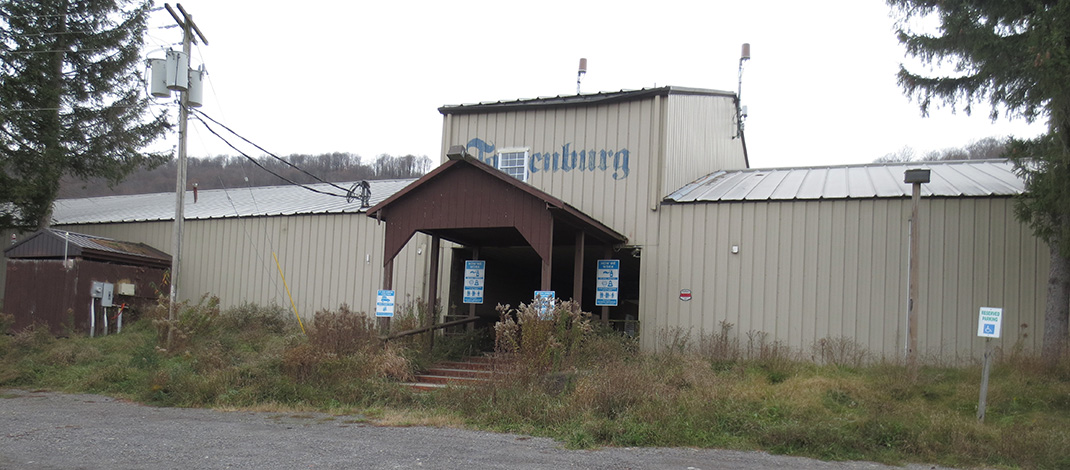The effort to re open the once thriving Toggenburg downhill ski area has been an uphill battle for three years now
By Aaron Gifford

With the snow just starting to fall for the winter season, the closest commercial ski property to most Oswego County and metro Syracuse area residents remains closed.
Toggenburg, located in Fabius just off Route 80, ceased operations in August 2021. It was purchased by Intermountain Management, which owns Song Mountain in Tully and Labrador Mountain in Truxton. The three properties are located within a 12-mile radius of each other and Togg was in direct competition with Intermountain Management before it closed.
In October of last year, New York State Attorney General Leticia James filed an anti-trust lawsuit against Intermountain, alleging that the company purchased Togg for $2.25 million with the intent to keep it closed and move its customer base to the other two ski centers. The litigation asks Onondaga County Supreme Court to order Intermountain to restore competition by selling one of its three mountains, according to court documents.
Peter Harris, Intermountain’s president, said the Togg property is still available for $1,995,000. That includes the land, buildings and equipment. Other than a few “tire kickers,” Harris said, there hasn’t been any serious inquiries about the property since it went up for sale.
There is no for sale sign on the property visible from its front entrance, but it is listed with Canaan Realty in Manlius. It does not appear the ski center has been maintained since it closed and the lawsuit alleges Intermountain is not making much of an effort to find a buyer.
“Each year Toggenburg remains closed,” the complaint says, “Intermountain profits at consumers’ expense.”
According to the Fabius assessor’s office, the 62.64-acre property is assessed at $465,000 and its market value is $665,000. The property is zoned for agricultural use. Its zoning variance that allowed for a commercial ski center expired because the business has been closed for more than a year, said Mike Decker, Fabius code enforcement and zoning officer.
Togg was especially popular with families from nearby Cazenovia and Manlius. In January of 2022, loyal customers from those two communities and other neighboring towns began a “Reopen Togg” movement, distributing thousands of bumper stickers and inviting like-minded local fans to post on their Facebook page.
“All we should ask is that he [Harris] sell it at market price with zero restrictions and let someone else decide to invest and manage it as they see fit,” Scott Phillips, the Reopen Togg Facebook page administrator, posted on the site.
The state’s case against Intermountain appears to be headed for trial. Intermountain was expected to file its list of witnesses and all supporting documentation earlier this fall and the attorney general’s office was ordered to file its certificate of readiness to proceed to trial by Dec. 1.
Presumably the court would need to discern if the new owners never had any intention to re open Togg or if they could not re open it due to financial and staffing problems following the pandemic. Another question is, can the region continue to support three commercial ski centers in such close proximity in addition to the Greek Peak resort, which is less than 30 minutes away. By contrast, there are two major facilities in the Rochester area (Swain and Bristol) and two large ski resorts in the Buffalo area (Holliday Valley and Kissing Bridge). Both metro areas have significantly larger populations than Central New York.
Smaller family-owned ski centers in the same proximity as Togg closed in the past four decades, including Mystic Mountain in New Woodstock and Ironwood Ridge in Pompey. But there is still a handful of much smaller downhill ski areas scattered throughout the region, including the Cazenovia Ski Club, Four Seasons in Fayetteville or the Camillus Ski Hill.
In a 2021 report, the Storm Skiing Journal and Podcast noted that in 1980 there were 75 ski areas across New York state. Thirty-eight of them have since closed.
“That New York has to compete against Vermont is hard enough,” the report said. “But most independent operators are also competing against New York itself.”
Paul Maroun, who served as a Franklin County legislator for decades before becoming Tupper’s Lake’s mayor, has experienced the challenges of trying to re open a popular commercial ski center.
Big Tupper, located in the Adirondack high peaks, sustained major damage during the ice storm of 1998 and officially ceased operations the following year. At one point the 300-acre facility re opened as a community-run facility, but that effort only lasted about two seasons due to lack of money and employees, Maroun explained. A developer then proposed to expand the ski center into a luxury resort with a golf course and condos, but the plan fizzled. Franklin County expects to acquire the property next year due to unpaid taxes and then it would be sold at public auction.
Before those unfortunate events, Big Tupper was already at a major financial disadvantage because it’s main competitors; the nearby Whiteface Mountain, Gore Mountain and Belleayre Mountain Ski Resort are all state owned.
“As popular as those places are,” Maroun said, “they don’t make money. If it wasn’t for taxes, I’m not sure all of them would still be open.”
Maroun said the costs to re-open existing ski centers are astronomical. Better water lines are typically needed to power the latest generation of snowmaking equipment. With the high price of lift tickets in a state with so many downhill facilities, serious skiers and families alike expect the highest-quality powder, ample parking, a competent ski patrol, more comfortable lodges and better food.
“You need all that just to be in the ballgame,” he said. “Expectations are so high now.”
He also said condos or villas, whether they are managed by the ski center or sold to wealthier customers, seem to be a big draw these days. A ski center owner has about as much chance of getting a bank loan as a farmer does, Maroun said, but plans for luxury real estate can catch investor’s eyes.
Maroun, who has experience with economic development projects, said deep pockets in the Central New York region like the Oneida Indian Nation or Micron, can provide a glimmer of hope that there are local investors available to re open Togg, “but you have to have someone with enough money to float the thing out for a few years.”
Still, downhill skiing has a major economic impact on New York state, according to research from the Ski Areas of New York (SANY) organization. SANY expects to release an updated report by the end of this year. Its prior analysis, which was published before the pandemic and Tog’s closing, says New York State leads the nation in number of operating ski areas, and it usually ranks fourth or fifth in the country in downhill snow sports visits, at 3.3 million to 4 million annually to the tune of more than $400 million. Fifty-one downhill ski areas were listed in the report, but that includes a few member-only ski clubs that own property.
“There is a ski area within 90 minutes of nearly every major metro area,” the report said. “This distribution makes skiing and snowboarding an important contributor to employment and quality of life for residents all over New York state.”




